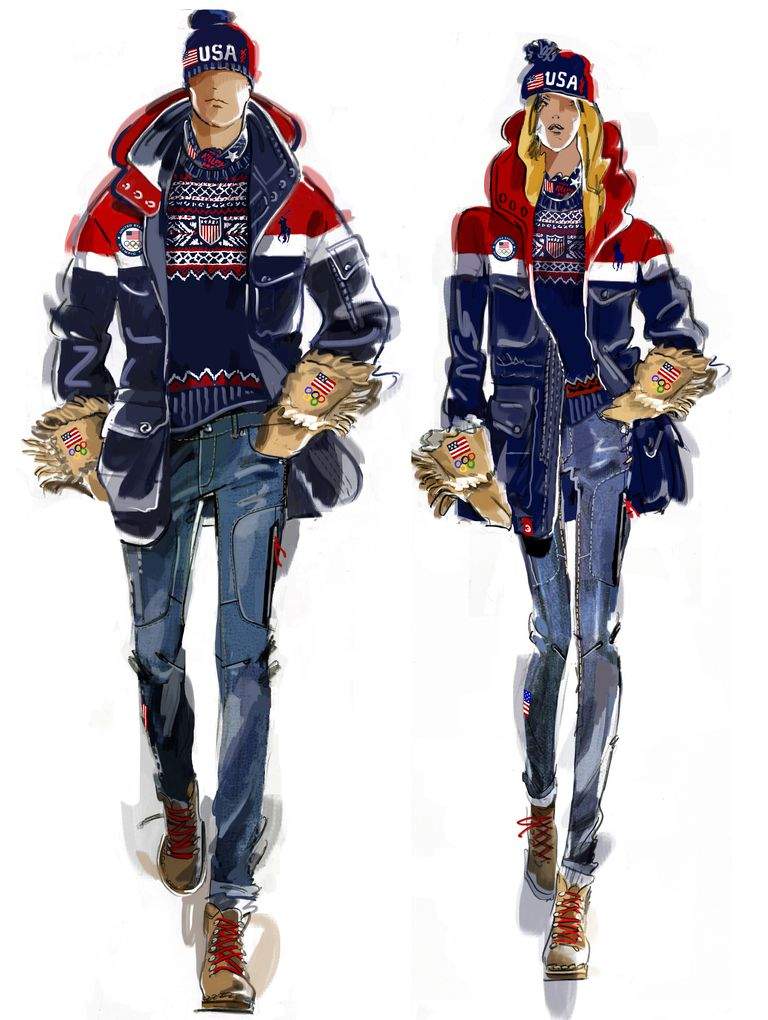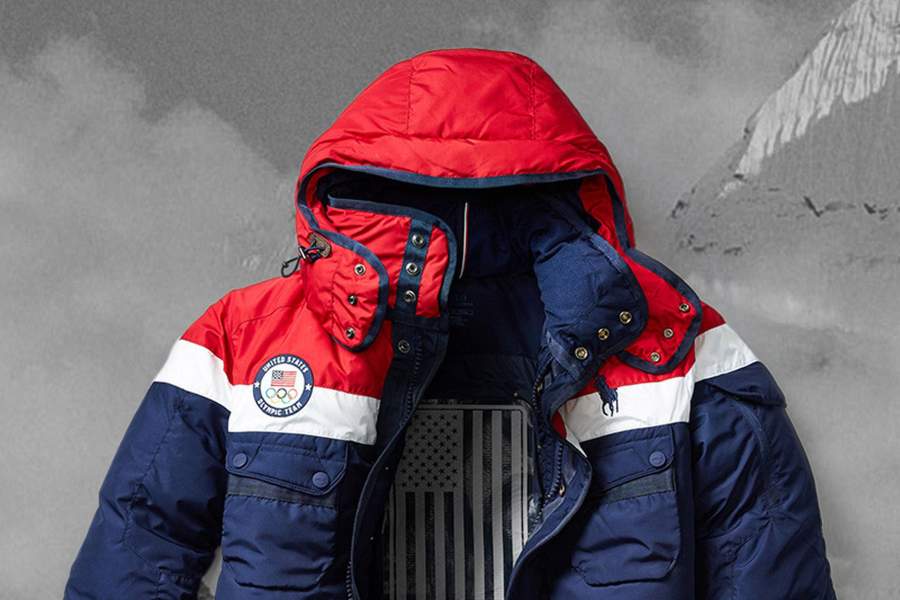Did you know that welding is an olympic event? Nope, I didn’t either.
Let me hop onto the bandwagon of mockery for Ralph Lauren’s latest disaster in the olympic event of “accessorization.”

The bulky coats are actually not too awful, but I’m afraid that’s mostly because they’re going to fit pretty much every athlete fairly well.
But the welding gloves. Well, I cannot support that at all; you don’t want things hanging down from your hands when you’re working in a machine-shop – getting danglies caught in power tools is a bad fashion statement. Why are they wearing welding gloves?!
It looks as though the Ralph Lauren shop had left-overs from the 1984 olympic “Marlboro Man” look.

(The image from 1984 is from when the olympics were held in KosovoSarajevo; “SAD” is not a commentary on the USA, it is the YugoslavianSerbo-Croatian way of saying “USA”)
The Tyrolian style hiking boots aren’t bad. Nothing screams “American!” like Tyrolian. And the denim pants are kind of snappy. Nothing screams “American!” like denim – which means “De Nîmes” – a particular cotton duck fabric made in the south of France. Nothing screams “American!” like cultural appropriation.
 I know I’m probably not rational about the olympics and how much I hate the idea of “national teams” and “national team costumes.” [stderr] [stderr] But Ralph Lauren and the US Olympic Committee keep playing right into my hand, with cheesy garbage that embarrasses instead of glorifies.
I know I’m probably not rational about the olympics and how much I hate the idea of “national teams” and “national team costumes.” [stderr] [stderr] But Ralph Lauren and the US Olympic Committee keep playing right into my hand, with cheesy garbage that embarrasses instead of glorifies.
It must be agonizing for the athletes, who know they have to play along with all the “Rah! Rah!” in order to go do what they really want to do. And they have to pretend to be enjoying the propaganda. Observe the pasted-on “oh, that is very nice. really!” smiles of the reaction to the 2014 uniforms:

Don’t give Trump the idea of having Trump Corporation (or maybe Ivanka) design uniforms for a military parade in Washington. It would be hilarious but expensive.


Addendum: I like the anime-slim angular look, too, but this outfit is for athletes not high-fashion models. Ralph’s team’s original design should be rendered on a range of body-types before it’s put into production. I doubt there is an olympic event where those skinny thighs are a typical muscle complement on an athlete. Just a suggestion.
There are some really sad and gloomy pictures [bi] of what the $110 million Olympic park at Sarajevo looks like now:

the bobsled run
The Ralph Lauren jackets include interior heating from a battery (i.e.: they’re like a snowmobile suit) and cost around $2,500 apiece. That use of the flag as lining is probably a violation of flag usage protocols – not that I care. The sweaters are $600. Miraculously, both have sold out. Even the welding gloves have sold out. [ralph]


Holy shit. That’s absolutely mortifying.
Well, there were sculpture and architecture competitions as a part of the Olympics from 1912 to 1948. I’m sure welding might have been involved in that to some extent.
That 1984 jacket looks like the Brokeback Mountain one.
The 2018 gloves look like a fire hazard.
cartomancer@#2:
I’m sure welding might have been involved in that to some extent.
It’d make a pretty cool event – if you scored based on the quality of the lines, speed with which they were welded, and weld-strength. The sad part is, if it became a matter of international competition (and therefore international cheating) there would probably be significant breakthroughs in welding gear and accessories, that would benefit everyone.
They would still not wear welding gloves with tassles, though.
chigau@#3:
That 1984 jacket looks like the Brokeback Mountain one.
I originally wrote “Brokeback Marlboro Man” but I didn’t want anyone to think I was saying there was anything wrong with Brokeback Mountain – though the Marlboro ads, as a scintillating example of selling via toxic masculinity, are a pretty soft target.
You may want to correct the caption: The 1984 Olympic Winter Games were held in the former Yugoslavia in Sarajevo, which is in Bosnia-Herzegovina, not Kosovo, and the language is Serbo-Croatian, not Yugoslavian.
What kind of model/athlete puts welding-gloved hands in tightfitting denim pockets?
Well I don’t know about welding as an Olympic event but I would like to see Tug of War brought back.
Speaking of welding, in that top drawing: the female person looks like she had her shoulders cut off and welded on lower down. Either that or she’s part giraffe.
Yeah, I know – the drawing was exaggerated for effect, but holy giraffe. That’s pretty extreme. The male drawing is at least plausible, although he’s got very droopy sloping shoulders.
The 1984 photo is… sad. Really sad.
The 1984 Winter Olympics were in Sarajevo, which was then in Yugoslavia and now in Bosnia-Herzegovina.
colinday@#10 and maxwell64@#6:
Thank you both; I fixed it.
Do they still do that? The occasional poster ad for tobacco I walk past seems to have devolved to generic pictures of people having fun (by some definition). They aren’t smoking and there is absolutely no association between them and the product other than a brand label and the standard issue marketing slogans. (“Smoking makes you free / happy / phenomenal / taller*” or an even more generic non-sequitur to tobacco) Designing tobacco ads these days must be the easiest job in the industry. 30 seconds googling a (any) beach picture, five minutes to add text and logos and you’re done.
*”And dead. Damn regulators for making us put this on here.”
I’m not too sure about that. You might just end up with a lot of semi-classified, impossibly expensive high-tech gear no one in their right minds would use because it isn’t economical. Still, in lieu of another space race I do like the idea of abusing the Olympics to drive technology forward. How about olympic well-digging and crop farming events just to help us brace for the future? A carbon capture event might also be useful but probably isn’t workable as a sport. (Picturing overly muscular athletes squeezing CO2 from the atmosphere and hammering it into the ground didn’t help)
Aside from the forced appreciation of the lousy uniforms, it is quite likely that the athletes don’t view the palaver as propaganda at all. In fact, I would assume most have been swept up by it and are themselves fervent believers of it.
Let me hop onto the bandwagon of mockery for Ralph Lauren’s latest disaster in the olympic event of “accessorization.”
Outfits of most other countries’ athletes are also ugly (at least in my opinion), so American athletes will be in a fitting company. At least they definitely won’t stand out as having the worst uniforms.
“SAD” is not a commentary on the USA, it is the Serbo-Croatian way of saying “USA”)
It’s funny when these things happen. I know a few other such examples. In Latvian “vista” means “an adult female chicken.” The Latvian word is spelled the same as the English word, and the pronunciation is pretty similar. Because of this, I have always been thinking about Windows Vista as the chicken software.
And the denim pants are kind of snappy. Nothing screams “American!” like denim – which means “De Nîmes” – a particular cotton duck fabric made in the south of France. Nothing screams “American!” like cultural appropriation.
While studying for my master’s degree in philology I took several comparative literature courses. In literature (and in culture in general) everybody copied from each other. Roman authors copied from Greeks, Europeans copied from Greeks and Romans, Germans copied from French, Latvians copied from Germans and so on. My master’s thesis was about the influence of German literature on Latvian literature; basically it was about how Latvian writers who lived at the beginning of the 20th century copied the writing style of German authors like Goethe, Nietzsche, Heinrich Heine and so on. Cultural appropriation is happening everywhere. Painting styles, literary styles, fashion, cuisine—everything gets appropriated everywhere. I don’t think you ought to criticize Americans for cultural appropriation, because everybody else has done that as well. By the way, as an artist, I have copied other artists’ styles and techniques.
Regarding the 2014 uniforms: they are so bad that I’d actually be willing to argue that they are objectively ugly. Fashion is subjective, what one person perceives as beautiful can be perceived as ugly by others. This is why I normally don’t make statements like “this is ugly,” instead I tend to say “I perceive this as ugly.” The fact that, in my opinion, ugly clothes (and ugly art in general) exists means that somebody perceived this stuff as beautiful. But for the 2014 uniforms I could argue that they are objectively bad. There are lots of randomly arranged details. These designs appear crowded and busy with no harmony whatsoever. The way how everything is arranged on those clothes is just a bad composition.
Observe the pasted-on “oh, that is very nice. really!” smiles of the reaction to the 2014 uniforms
Here’s a photo of Latvian 2018 uniforms. https://static.lsm.lv/media/2017/11/large/1/8iwl.jpg Notice the facial expressions of most people there. From an American perspective my behavior may seem direct and straightforward, but I’m perfectly normal for the average Latvian. Here people don’t bother smiling unless it is part of their job description. Latvian waiters or athletes or pretty much everybody won’t bother smiling when they don’t want to. When Latvians smile, that’s because we actually are happy at the moment. Only actors, models etc. smile on demand, because there that really is part of their job duties.
It’s the same with word choices. Latvians generally skip euphemisms and just say what they think. For this reason you should never ask a Latvian if those pants make you look fat unless you can stomach the answer, because you will get a frank and honest non-watered-down answer without any sugar coating. Personally I find American insistence on fake smiles and indirect word choice mildly annoying: it just makes it harder for me to figure out what is going on. If somebody says “I’ll think about it” instead of “No,” or “That’s a pretty good idea, but how about if…” instead of “That idea is terrible. Instead you should…” that’s inefficient communication. I don’t like it when people are required to sandwich any unfortunate truths between compliments, or buffer it with pleasantries. To me this beating around the bush is a waste of time; it’s just an annoyingly verbose and roundabout way of saying something much simpler.
Regarding tobacco advertisements: I’m lucky to live in a place where tobacco ads are banned altogether. And laws require that most of the package is covered with graphic photos of sick or dead people. Here’s a sample of how tobacco packages look here – https://likumi.lv/wwwraksti/2016/097/BILDES/N_306/2_3_306.JPG For me it feels like it’s working. I remember that 15 years ago people (at least those young people I used to spend time with) perceived smoking as cool. Now it seems like people are starting to perceive smoking as an expensive addiction. Excise tax on tobacco has gotten pretty high by now. And the government keeps on regularly increasing it. And we have also gotten laws that ban smoking in many places (for example, smoking in public transport stops is forbidden). I’m happy that society’s perception of smoking is shifting from “cool” to “undesirable.”
Ieva Skrebele@#14:
Outfits of most other countries’ athletes are also ugly (at least in my opinion), so American athletes will be in a fitting company. At least they definitely won’t stand out as having the worst uniforms.
Yes, I have to say that generally they are terrible.
This year there are some really amazingly bad things, which the US is hardly near the top of. I suppose the gold medal would go to Bermuda, who made their athletes wear Bermuda Shorts in South Korean winter. And much respect to the Tongan flag-bearer, who went shirtless. But otherwise, the whole event seems like a chance for nationalists to discredit nationalism.
everything gets appropriated everywhere. I don’t think you ought to criticize Americans for cultural appropriation, because everybody else has done that as well
I have occasionally made that same argument, so I suppose I am being inconsistent. My view is that cultural artifacts are intended to be copied – that’s what culture is – and therefore it’s inconsistent to complain when someone adopts your cultural signals. Also, with respect to art and other creative things, everything is within the cultural context that birthed it, and it’s not possible to really invent something new, we’re always left remixing the things that culture offers us.
Regarding the 2014 uniforms: they are so bad that I’d actually be willing to argue that they are objectively ugly.
Wow! That’s a hard argument. But you might be able to pull it off.
That would make a fun debating topic.
And much respect to the Tongan flag-bearer, who went shirtless.
Well, at least he looked really sexy. Personally, I prefer different haircuts for guys, but, other than that, he’s definitely hot.
Wow! That’s a hard argument. But you might be able to pull it off.
That would make a fun debating topic.
Yeah, I know that’s a problematic argument. Arguing that something is objectively ugly is hard. That’s why I don’t make this argument often. Whoever is arguing against me can simply say, “But I perceive it as beautiful.” And that’s it, that’s enough to make me lose the argument.
Human perception of beauty largely depends on what we have been exposed to previously. If we have seen something similar before and gotten used to perceiving it as beautiful, then our brain tells us that whatever we are seeing now is beautiful. For example, humans perceive average faces as beautiful. (I found it really fun to play with software that creates average images of multiple human faces.)
When whatever it is that people are exposed to changes, so does our perception of what’s beautiful. There are countless examples of perception of beauty shifting over time. For example, small female feet used to be perceived as beautiful in China, yet nowadays people perceive them as deformed and ugly. Another nasty example—a few centuries ago Europeans perceived dark skin as ugly. Perception of how a beautiful female body ought to look like has shifted too—women in Ancient Greek sculptures have smaller breasts and more fat on their bodies compared to modern supermodels.
Still, it seems to me that there really are some innate standards of beauty. For example, humans perceive symmetrical faces as beautiful. We also perceive physical signs of illness as ugly (is there really anybody who perceives acne as beautiful?). People also have a tendency to seek patterns. Compositions where everything (all sorts of shapes and colors) is randomly thrown together with no harmony whatsoever seem for me as not pleasing for the human eye. And this is exactly how those 2014 uniforms look. All those different shapes and colors are just thrown on these jackets and that’s it.
Besides, I could always cheat a little. I could slightly manipulate the wording of the claim that I’m defending so that my claim is easier to prove. A claim “this outfit is objectively ugly” can be disproven with “but I perceive it as beautiful.” A claim “this outfit is an objectively bad design, because majority of people perceive it as ugly” is simpler to prove. The short version of my argument would be:
1. Human brain seeks patterns and harmony in compositions, because that’s what we perceive as beautiful.
2. This outfit lacks any harmony whatsoever, it’s just crowded with all sorts of shapes and colors, which look like they were just randomly thrown together. Therefore it is bad composition and most people will perceive it as such.
3. A fashion designer should strive to make clothes that will be perceived as beautiful by most people. Otherwise you get a bad design.
Conclusion: As a result, in this case we get this outfit, which is an objectively bad design.
In debates I like to simplify my life by never going for wide and absolute claims, which can be easily disproven by finding just a single counterexample. In order to consistently win debates, I must carefully choose, which claims I’m willing to defend and limit how wide I want to make them.